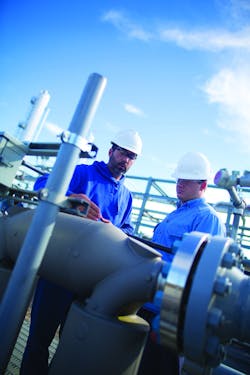Flowmeter diagnostics optimize production in process plants
Several years ago, in a Flow Control article titled "Verifying Coriolis flowmeter calibration," Tom O’Banion with Emerson wrote that the perfect flowmeter never drifts or wears. It never needs zeroing. It measures in mass units. It is immune to the effects of changing fluid properties and fluid dynamics, density, viscosity, Reynolds number, speed of sound, swirl and irregular profile. It features advanced diagnostics capable of thoroughly checking any abnormal conditions, perhaps even sending text messages to relevant stakeholders to provide advanced notice and guidance on how to remedy the condition. And, ultimately, the diagnostic data is accepted by regulatory agencies in all industries.
While that list of desired qualities for the perfect flowmeter was described three years ago, today, the future is much closer — with advances in diagnostic tools and the software running them.
Advances in technology have allowed for significant leaps forward in product development. In particular, many of the chips needed to power diagnostics have become small enough to fit in a transmitter or wireless diagnostic tool.
Courtesy of Emerson Automation Solutions
Diagnostic advances
Until recently — and this is still the norm in many plants and oil fields — diagnosing a meter meant physically going to the meter and taking readings, resetting certain parameters and then uploading or manually entering the collected data into a computer. Today, this can be accomplished much faster and more efficiently through advanced diagnostic capabilities built into the device with the ability to transmit that information directly to a laptop, tablet or network.
The benefits of online diagnostic data collection fall into three categories: safety, time and cost. The following looks at each one.
Safety
Not having to physically check the meter means personnel are not exposed to product in the pipeline. It also means there is no shutdown needed to check the meter. During abnormal operation, such as shutdown and startup, safety risks are greatest, including individual exposure to process fluid.
There are also inherent dangers to the process and the product at startup and shutdown separate from the dangers to personnel. With any process disruption, there is a high probability that product immediately before and after the shutdown will not meet specifications and will need to be discarded, resulting in product loss, material loss and profit loss — something no plant manager wants.
Real-time or online quality checks, such as measurement of density, concentration or even gas void fraction, can reduce the need for manual sampling and the associated risks.
Many work practices today include frequent manual sampling of the process. This may mean that workers are opening valves, catching samples, transporting them to the lab and testing the samples. All of this creates additional risk for exposure. Real-time or online quality checks, such as measurement of density, concentration or even gas void fraction, can reduce the need for manual sampling and the associated risks.
Time
The time regained by not having to physically check every meter is tremendous. It is not only time-saving, but also cost-saving.
A meter with advanced diagnostics can provide alerts to problems in the process that a technician can address before process upsets occur. As a result, regular maintenance can now be scheduled; plant and meter maintenance becomes proactive instead of reactive; and schedule-based maintenance is not needed if the diagnostics can ensure the meter is working properly.
Cost
Diagnostic costs can add up, particularly when a meter needs to be removed from the line and sent to a laboratory for testing and servicing. For large meters, it can involve cranes or other equipment to remove the meter.
In all cases, the process that flows through that particular meter needs to be stopped, and unless a plant has a spare meter, production is stopped until the recalibrated meter is slotted back into place. This can be costly; however, the alternative could be worse. An incorrect meter can cause any number of problems and can lead to fines for not meeting regulatory requirements and environmental standards. To head off these added expenses, a meter with advanced verification diagnostics that can produce on-site reports accepted by regulatory agencies can provide significant year-over-year cost savings.
Meter verification
Meter verification typically consists of checking the health of the sensor and transmitter. The diagnostic indicators should be in the normal state to help verify the equipment is working. Checking the configuration for the sensor parameters and making sure they have not changed is also important. While sensor verification will vary by manufacturer, it will — in general terms — check for a change in the measurement performance. This check can run continuously, on demand or on a periodic basis. Some manufacturers provide automated meter verification functionality that can be executed without interrupting the process or the measurement and may even provide scheduling functionality to run the verification at an established interval.
Connecting the dots
Collecting data is only part of the story. Having it readily accessible and being able to effectively use it is the other half.
Several sensor and meter manufacturers now provide software applications that live on a dashboard — on a smartphone, tablet, laptop or desktop — and display all relevant information in an easy-to-read format. These apps can be set to alert personnel to process upsets before they become critical, offering yet another layer of security through advanced diagnostics.
Purpose-built software apps for each device help connect the dots along the process and offer greater peace of mind. Information becomes available at a glance, thereby optimizing operations.
Third-party acceptance
As mentioned, reports generated by advanced diagnostic tools can be used to meet reporting requirements set by third-party agencies. This is important because the regulations that govern different industries can set stringent rules that affect processes. From environmental regulations to safety considerations, it is helpful to have a robust process to verify performance and document the verification.
Being able to provide that information on a regular basis with reports printed from data received and collated — without needing to stop processes to take meters out of line — means compliance requirements become easier to meet.
Statistical trending of meter performance and process offers the tools to optimize productivity while remaining compliant. Tweaks to a system can be tracked through the data gathered. Two-phase flow can be more closely monitored and reported.
Statistical trending of meter performance and process offers the tools to optimize productivity while remaining compliant.
Meter verification tools will not always replace proving or calibration, but they can extend intervals between proving and calibration because meter health can be checked on-site with data downloaded from the meter daily, weekly or monthly. This data will also help meet the contractual and/or legal obligations that are part of operations.
Optimizing processes
Businesses and manufacturers from a range of industries are constantly seeking the right tools to optimize processes. Finding the right tools and diagnostics to ensure that a plant can run at peak efficiency and safety within established parameters can be challenging, especially if a plant is running legacy equipment.
Using advanced diagnostic tools that provide real-time insight into the meter means processes can be fine-tuned as needed without interrupting the process, thus helping ensure plant managers meet optimization goals.
Tonya Wyatt is a global senior product manager at Emerson. She is responsible for Micro Motion flow and density measurement transmitters and software. Wyatt holds a bachelor’s degree in chemical and petroleum refining engineering from the Colorado School of Mines with a minor in environmental science and engineering and an MBA from the University of Colorado. She has been with Emerson since 2000 in roles including applications, new product development, product management, gas marketing and chemical industry marketing. Wyatt worked for Eastman Chemical Company in the research and development group prior to joining Emerson. She is a certified Project Management Professional and a member of the American Gas Association (Transmission Measurement Committee), American Institute of Chemical Engineers, Society of Women Engineers and American Chemical Society. Wyatt can be reached at [email protected].




